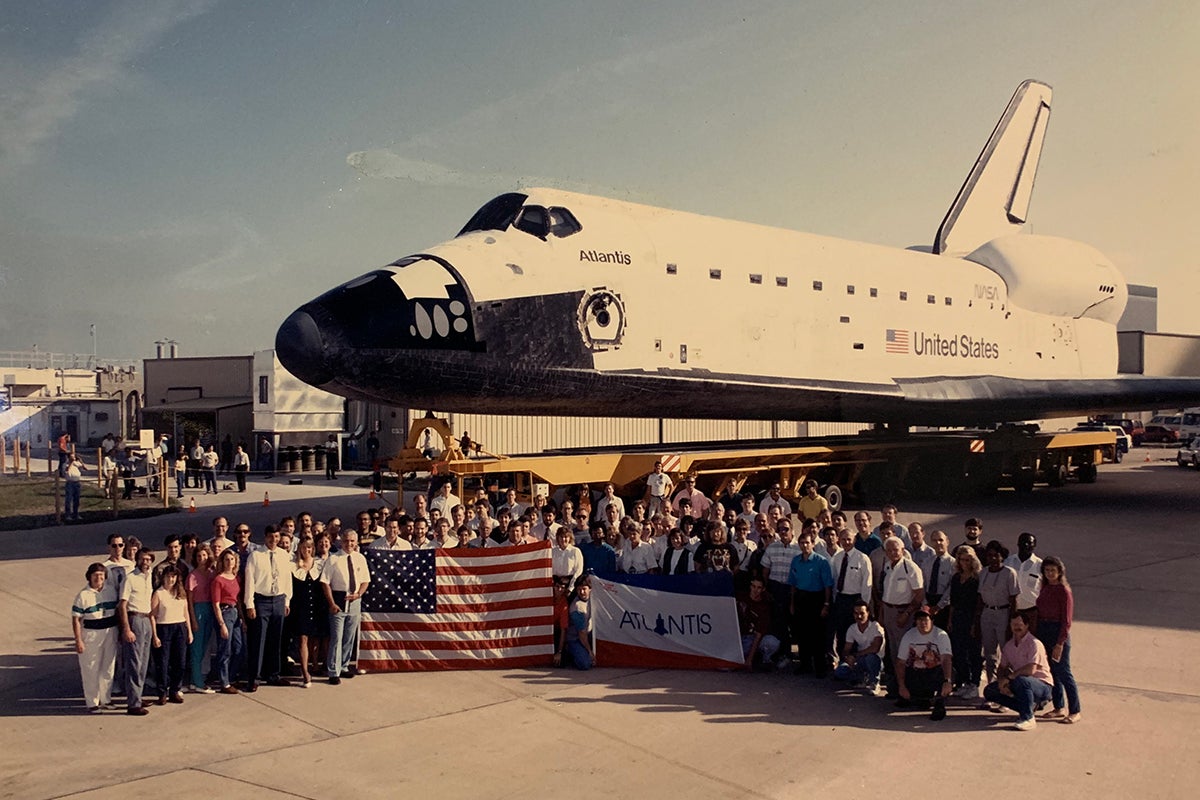When the U.S. space shuttle program shut down in 2011, the biggest loss wasn’t just to the local Space Coast economy, but to the nation — as six decades of rocket-launching expertise was diluted, says University of Central Florida planetary scientist Phil Metzger ’00MS ’05PhD.
Metzger, a 30-year veteran of NASA, has seen the rise, fall and, with today’s scheduled SpaceX launch of the commercial space company’s Crew Dragon capsule, the resurrection of the nation’s crewed missions into space. He witnessed some of the earliest Apollo launches from his boyhood home in Titusville, near where his dad worked as a quality-control inspector for NASA. When he grew up, he went to work for NASA, including on the space shuttle program during its iconic years in the 1980s and ’90s.
After working on the shuttle program as a systems engineer in navigation from 1985 to 1992 and as part of the countdown team, Metzger switched to working on the International Space Station, where he helped lead efforts to test and troubleshoot it before launch.
In 2002, Metzger began working as a senior research physicist at NASA’s Kennedy Space Center and earned his doctorate in physics from UCF in 2005.
As a physicist at NASA, he helped co-found the Granular Mechanics and Regolith Lab, which later became NASA’s Swamp Works rapid development lab, and also helped investigate the 2003 Columbia disaster as part of a team analyzing videos to understand the physics behind what led to the shuttle’s breakup and explosion.
In 2014, after 30 years at NASA, Metzger joined UCF’s Florida Space Institute as a planetary scientist developing technology for space mining and resource extraction in space.
“The U.S. had spent six decades building up the launch team without a break hardly from early research rockets to Mercury and Apollo and to the end of the shuttle,” says Metzger, who will once again be witnessing history as Americans return to space from Kennedy Space Center.
“That launch team was a national treasure and having that concentration of skills was really unparalleled anywhere in the world. It was a loss to have that expertise dissolved. People had to get jobs elsewhere and move away. And then there was an almost 10-year period that we weren’t doing launches, so we weren’t training up the next generation of people.
“So that caused a dip in the amount of concentrated expertise we had in the American space program. But now, we’ve been rebuilding that. We’ve got a couple of different commercial companies that over the last few years have been getting ready to launch humans. They’ve been learning the processes that are the extra rigor necessary for human-centered launches.”
The last American crewed flight to orbit Earth was on space shuttle Atlantis in 2011, after which the U.S. government retired the shuttle program to explore more efficient ways for Americans to travel to space.
In the meantime, Americans have ridden on Russia’s Soyuz rockets to get to the International Space Station.
The SpaceX launch on its Crew Dragon capsule mounted atop its Falcon 9 rocket is the first American-crewed mission to Earth’s orbit in nearly a decade. The launch is expected to draw thousands of onlookers in-person and many more on television and online.
The SpaceX mission is extremely important to U.S. national security and its need to move industry off of Earth and mine resources in space, an enterprise projected to be worth trillions of dollars in the coming decades, Metzger says.
“By the end of the century or sometime next century, I believe there’s going to be more economic activity off the planet than there is on Earth.” — Planetary Scientist Phil Metzger ’00MS ’05PhD
“By the end of the century or sometime next century, I believe there’s going to be more economic activity off the planet than there is on Earth,” he says. “There’s an economic incentive to move in that direction. So, when that time comes, the nations of Earth that are geopolitically influential are going to be the ones that had industry in space.
“And it’s important for political security to be able to put humans into space from here. I’m hopeful we’ll be able to be friends with all the nations of the Earth in a cooperative environment, but you never know. You’ve got to be prepared for contingencies.”
In addition to SpaceX, other companies, including Boeing with its CST-100 Starliner capsule, are working toward crewed space flights launching from the U.S.
Metzger says that even though the shuttering of the shuttle program had some negative outcomes, the time had come for a different design for space travel.
“One of the basic problems was the shuttle was just not a great design,” Metzger says. “It was this big vehicle with wings that can fly back and land on wheels. And in order to do that, they had to put it on the side of the rocket.
“It’s interesting what SpaceX has done is that they’re putting the crew capsule back on the top of the rocket again like it was in Apollo.”
Metzger says he wasn’t surprised when the shuttle program was shut down since it was expensive, there was growing consensus that a different design was needed, and with the space station up and running in 2000, there wasn’t a need to carry as much payload along with the astronauts on the trips to space. What did surprise him, he says, was that it took nearly 10 years for America to get people back into space again.
“We’ve all been working on space as hard as we can this entire time,” Metzger says. “We really didn’t slow down. It’s just that one activity of launch clearance wasn’t happening. So, I’m really excited that we’re finally going to get that back as part of what the U.S. can do.”




